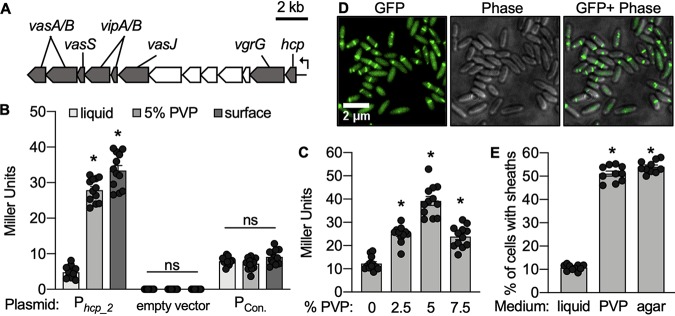FIG 2.
Viscosity regulates T6SS2 transcription and sheath formation. (A) Gene map for the predicted multigene operon (VFES401_RS15775 to VFES401_RS15830) (40) within the V. fischeri T6SS2 genomic island showing conserved T6SS genes (gray) and genes of unknown function (white). (B) β-Galactosidase assays were performed on cells grown on agar surfaces or in low-viscosity (liquid) or high-viscosity (5% PVP) medium. Treatments included ES401 harboring a T6SS2 reporter plasmid (pAG01), the empty vector (pAKD701), or a constitutive promoter (pJLB207). (C) β-Galactosidase assays were performed on ES401 cells harboring pAG01 grown in high-viscosity liquid. (B and C) *, P < 0.0001 by a Student's t test comparing Miller unit values between treatments; ns, not significant (P > 0.05). (D) Representative GFP images, phase-contrast images (Phase), and an overlay of GFP and phase-contrast images of ES401 cells expressing VipA_2-GFP after incubation in high-viscosity liquid for 2 h. (E) Percentage of VipA_2-GFP-expressing cells that contain sheaths after being incubated in low-viscosity liquid (liquid) or high-viscosity liquid (PVP) or on an agar surface (agar) for 2 h. All medium types were supplemented with 0.5 mM IPTG (isopropyl-β-d-thiogalactopyranoside) to induce expression of VipA_2-GFP. *, P < 0.0001 by a Student's t test comparing the percentage of cells with sheaths in liquid to the percentage of cells with sheaths on hydrogel or agar surfaces. Error bars indicate standard errors. Experiments were performed two (E) to three (B and C) times, and combined data are shown (n = 12 for panels B and C and n = 20 for panel E).

